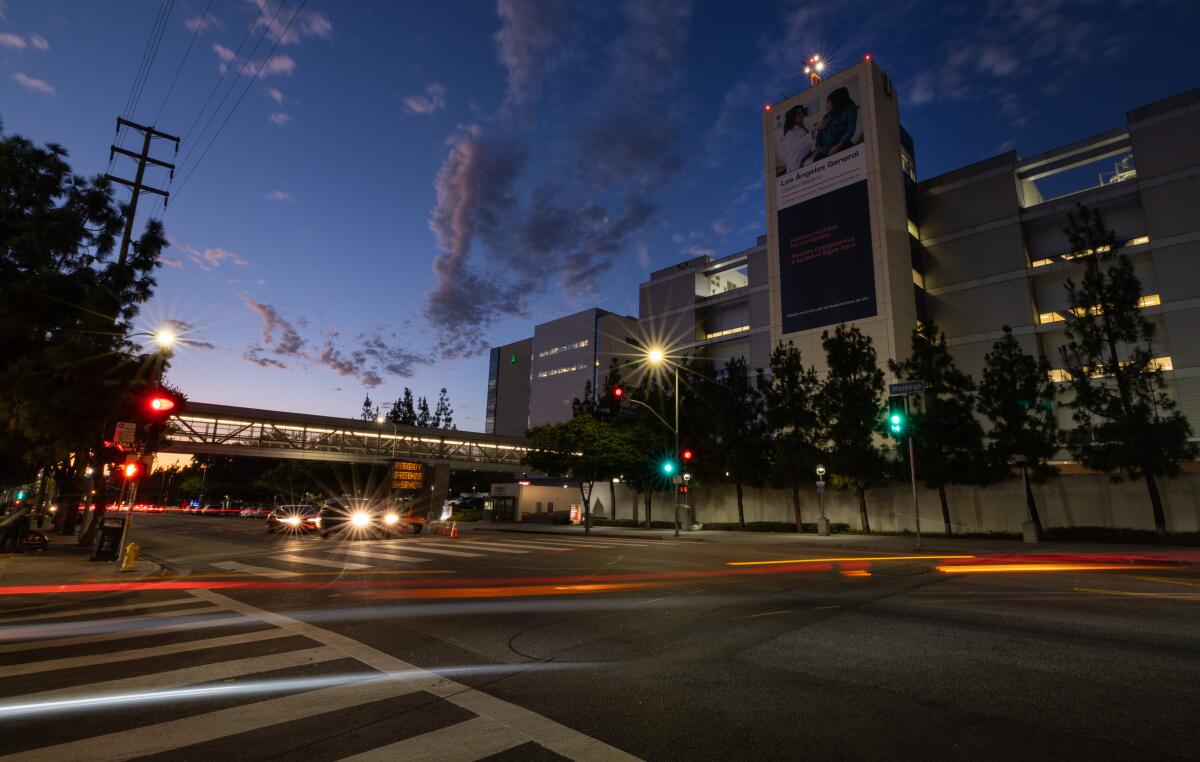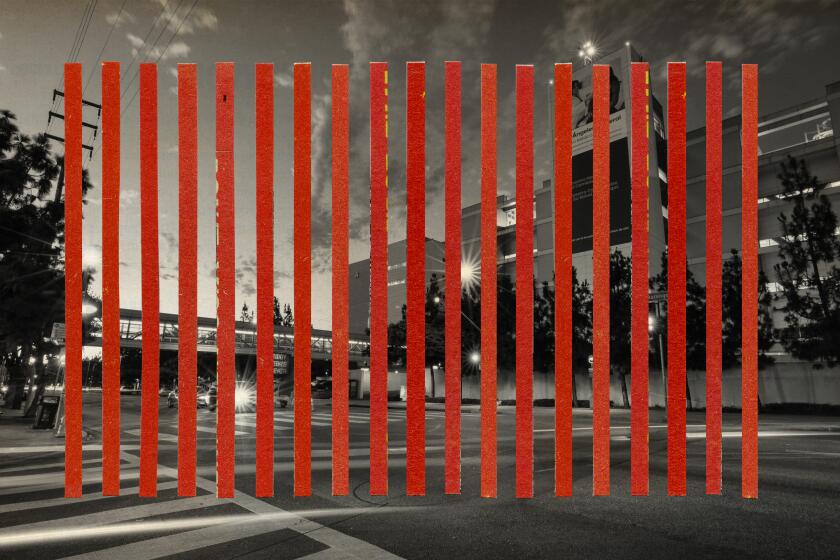‘Scandalous’: L.A. General again among highest in U.S. in restraining psychiatric patients

- Share via
Los Angeles General Medical Center restrained patients in its psychiatric inpatient unit at the fourth-highest rate of any such facility in the United States, newly released annual figures show — the latest evidence of a persistent pattern that has troubled local leaders and mental health advocates.
Under federal law, hospitals are prohibited from restraining psychiatric patients except to prevent them from harming themselves or others. Patients are supposed to be strapped down only as a measure of last resort after other steps fail. Experts warn it can traumatize patients, damage trust and ramp up the risk of injuries.
The L.A. County-run public hospital again had the highest rate of restraining psychiatric inpatients of any facility in California, according to data released this week by the Centers for Medicare & Medicaid Services. The latest figures from the federal government cover the year 2022.
During that year, L.A. General’s inpatient psychiatric unit, which is located at the Augustus F. Hawkins Mental Health Center in Willowbrook, had a restraint rate 48 times higher than the national average.
Its restraint rate far exceeded those at Zuckerberg San Francisco General Hospital — a public hospital serving San Francisco — and at Bellevue, another large safety-net facility in New York City.
“That’s scandalous,” said USC law professor Elyn Saks, who has studied the use of restraint for decades. Saks said the county should examine the practices of other facilities that use restraint much less frequently, including in other countries.
Restraint is “a practice that is pretty widespread here, and it doesn’t need to be that way,” she said.
A Times investigation digs into what is driving the high use of restraints at L.A. General Medical Center.
The latest figures follow a Times investigation last fall that found restraint rates at L.A. General ranked among the highest in the country between 2018 and 2021.
A Times review of county reports identified 200 cases in which psychiatric inpatients were restrained for a total of 24 hours or more in a month, including dozens restrained for the equivalent of a week or more.
The new figures show that in 2022, the restraint rate at L.A. General fell closer to the levels it had been before the COVID-19 pandemic. The rate doubled from 2020 to 2021. County officials previously said that efforts at Hawkins to control the spread of the coronavirus — including halting group occupational and recreational therapy — probably contributed to that increase.
The Department of Health Services, which runs the county hospital, said in a statement that restraint rates at Hawkins “reflect the need to protect the safety of patients and staff and are heavily influenced by a small number of extremely violent patients awaiting placement in locked County or State facilities.” In the past, county officials said that long waits for longer-term care had made patients more agitated.
The county agency also cited “the restraint hours required to keep patients and staff safe during transport between facilities.” Hawkins is far from the main campus of the hospital in Boyle Heights, which county officials previously estimated had led to more than 1,400 hours of restraints during transportation in one year.
In reaction to The Times’ findings last year, the health services department also argued L.A. General could not be fairly ranked against other hospitals that did not accept the same kinds of challenging patients that it handles as a safety-net hospital near Skid Row.
Mental health experts took issue with many of those explanations, noting that the L.A. General rates were far higher than those of safety net facilities such as Zuckerberg and Bellevue. Some criticized the blanket practice of restraining patients while they are transported from one campus to the other, calling it excessive.
In the aftermath of The Times’ investigation, two L.A. County supervisors publicly called for health officials to find alternatives to physically restraining Hawkins patients.
Supervisor Hilda Solis, whose district includes the main L.A. General campus in Boyle Heights, said in October that she was “working to identify ways to drive those rates down,” including bringing the psychiatric unit onto the main campus. Supervisor Holly Mitchell, who represents the area where Hawkins is located, said she wanted a public discussion of the issue at a Board of Supervisors meeting.
So far, no such discussion has happened. Solis and Supervisors Janice Hahn and Lindsey Horvath did not provide comment on the new figures.
Supervisor Kathryn Barger said in a statement that the newly released figures reflect the “systemic challenges and realities” facing L.A. General staff, echoing points raised by the health services department.
“Other hospitals can turn them away, but the county cannot — we are the safety net. So the most violent and severely mentally ill end up here,” Barger said. She also said that the county lacked “a network of secure inpatient psychiatric facilities that can effectively treat violent psychiatric patients.”
In a statement, Mitchell called it “a complex problem” and said Hawkins has a higher share of violent and severely mentally ill patients than other facilities.
Mitchell, who visited Hawkins and spoke with staff, raised concerns about “an out-of-date building that is not designed, as modern psychiatric facilities are, to promote well-being and healing,” as well as the need for more therapeutic beds and a funding system “that recognizes some patients have more severe needs than others.”
“My expectation remains that DHS continues to evaluate its techniques for serving our residents with dignity and care and ensures the use of restraints only when absolutely necessary,” Mitchell concluded, referring to the Department of Health Services.
At a meeting this week of the L.A. County Hospitals and Health Care Delivery Commission, which advises the county supervisors on patient care, Commissioner Barbara Siegel asked to discuss the issue of restraint at an upcoming meeting, citing the Times investigation.
“The big question is, what is the county doing to bring about a reduction?” Siegel said.
L.A. General’s inpatient psychiatric unit has restrained patients at a higher rate than in any other in California, a Times analysis has found.
Dr. Roderick Shaner, former medical director of the county mental health department, said county supervisors should make it clear to hospital officials that reducing restraint is a priority and “that they would like to have confidence that L.A. General leadership continues to take it seriously.”
“External examination is a very potent thing,” said Shaner, who worked to reduce the use of restraints in psychiatric facilities in L.A. County before his retirement in 2018. “Simply knowing one is being monitored will inspire people to look for other ways to do things.”
In addition, county leaders “should be demanding that the hospital leadership bring in outside experts,” said Pamila Lew, policy counsel with Disability Rights California. Lew said the best move would be to bring in people running similar kinds of facilities. “If it’s just outsiders coming in ... trying to tell them what to do, that’s going to be perceived very differently from a peer who says, ‘Yeah, I know this is really tough, but have you explored doing X, Y and Z?’”
Kathleen Crowley, executive director of the Procovery Institute, which has provided training to hospitals on reducing the use of restraint, said she was “profoundly disappointed” by the L.A. General figures.
To bring down the numbers, county supervisors need to give a “clear directive” to reduce the use of restraint and consult with the hospital on what resources it needs to make that happen, she said.
Crowley said she understands why hospital officials might think their challenges make that impossible. But “I’ve seen it done over and over,” she said, recounting her experiences at hospitals that serve people with criminal records related to mental illness.
More to Read
Sign up for Essential California
The most important California stories and recommendations in your inbox every morning.
You may occasionally receive promotional content from the Los Angeles Times.














